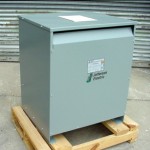Pad Mount Transformers – Dangerous Sampling Valves
One common concern with pad mount transformers is in the area of oil sampling. Companies with large pad mount transformers may sample and test the oil in the transformers annually to determine the reliability of the transformer. The condition of the oil reflects the current state of the transformer. Now here’s where it gets tricky. Large pad mount transformers are designed with two cabinet doors. One door exposes the high voltage cables and bushings and the other door exposes the secondary, low voltage, side. The sample valve can be located in either compartment but most of the time the valve is located in the secondary cable side. Years ago it was not uncommon for an intrepid technician with nerves of steel to pull an oil sample from an energized pad mount transformer, the valve being located at the bottom of the transformer while hot cable lugs were located only a couple feet above the oil valve. With safety becoming a paramount concern in industry today, it is no longer prudent nor standard practice to pull an oil sample on an energized pad mount transformer. The hot lugs being within short reach of the technician create a shock hazard. And the secondary side of a transformer is one of the most dangerous arc flash hazards there is. Oil sampling is now performed only during scheduled shutdown of the transformer.
However, there still remains somewhat of a challenge when it comes to pulling an oil sample from a pad mount transformer. The secondary compartment of pad mount transformers can be a pretty fully house. There may be as many as six cables attached to each secondary bushing, making it very difficult to access the sampling valve through that jungle of vines. One way around this, literally, and we’re finding it used more and more in industry, is extending the sample value system to a small secure box on the exterior of the transformer enclosure. The valve would then be enclosed in a newly created box with a locked access door mounted on the exterior wall of the cabinet. In this way the transformer can be sampled at any time, while energized, without exposing the technician to shock or arc blast hazards.
